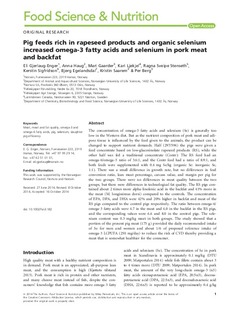| dc.description.abstract | The concentration of omega-3 fatty acids and selenium (Se) is generally too low in the Western diet. But as the nutrient composition of pork meat and adipose tissue is influenced by the feed given to the animals, the product can be changed to support nutrient demands. Half (297/594) the pigs were given a feed concentrate based on low-glucosinolate rapeseed products (RS), while the other half was fed a traditional concentrate (Contr): The RS feed had an omega-6/omega-3 ratio of 3.6:1, and the Contr feed had a ratio of 8.9:1, and both feeds were supplemented with 0.4 mg Se/kg (organic Se: inorganic Se, 1:1). There was a small difference in growth rate, but no differences in feed conversion ratio, lean meat percentage, carcass value, and margin per pig for the two groups. There were no differences in meat quality between the two groups, but there were differences in technological fat quality. The RS pigs contained about 2 times more alpha-linolenic acid in the backfat and 41% more in the meat (M. longissimus dorsi) compared to the controls. The concentration of EPA, DPA, and DHA were 42% and 20% higher in backfat and meat of the RS pigs compared to the control pigs respectively. The ratio between omega-6/omega-3 fatty acids were 4.7 in the meat and 4.0 in the backfat in the RS pigs, and the corresponding values were 6.6 and 8.0 in the control pigs. The selenium content was 0.3 mg/kg meat in both groups. The study showed that a portion of the present pig meat (175 g) provided the daily recommended intake of Se for men and women and about 1/6 of proposed reference intake of omega-3 LCPUFA (250 mg/day) to reduce the risk of CVD thereby providing a meat that is somewhat healthier for the consumer. | |

